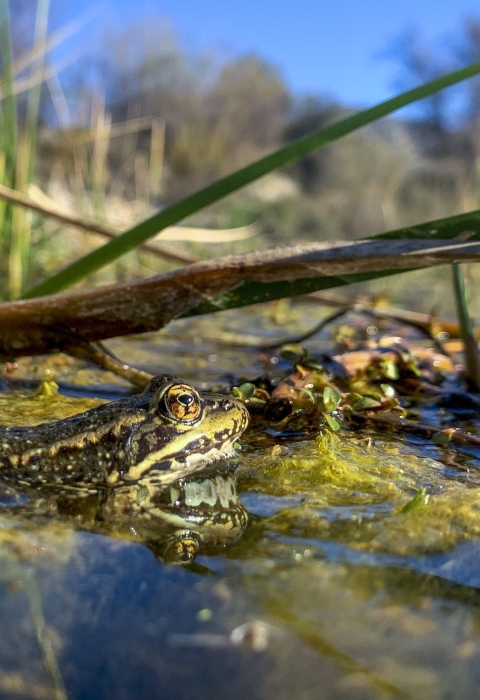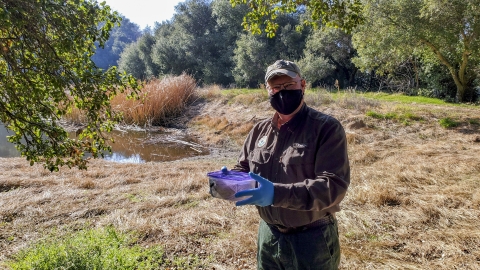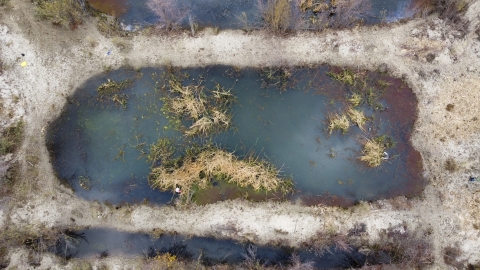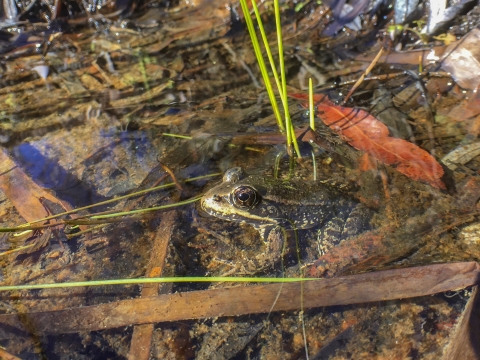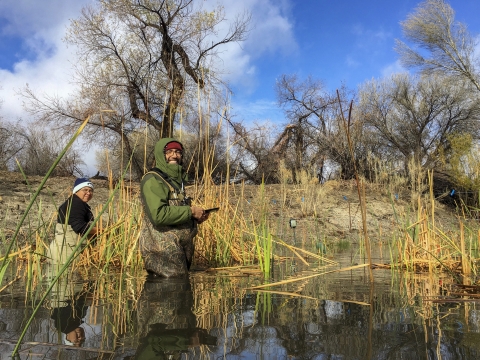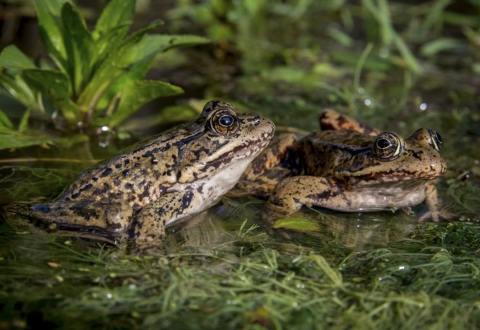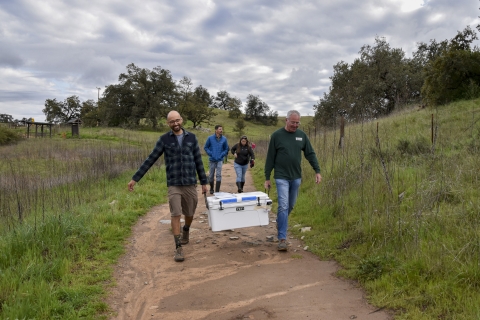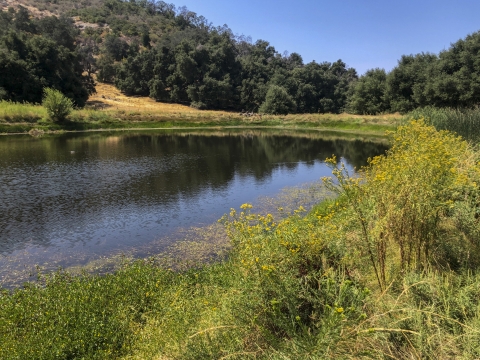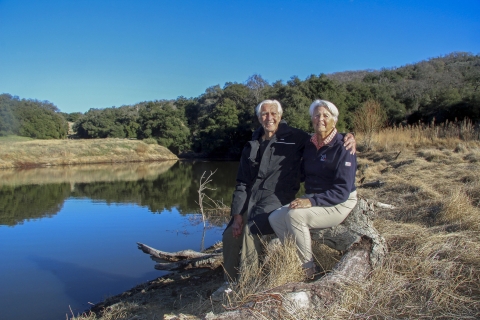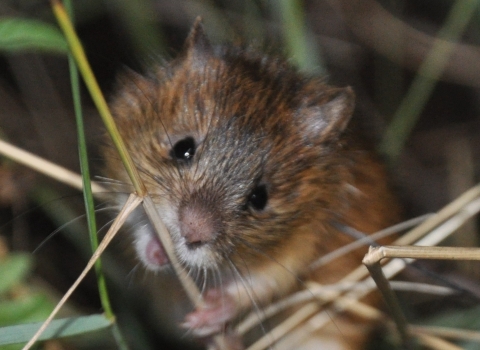“It was serendipitous,” said Clark Winchell from the U.S. Fish and Wildlife Service about a recent collaborative endeavor to bring California red-legged frogs back to their natural habitat in Southern California after they were extirpated decades ago.
The effort to return the frogs to Southern California, which had been ongoing by Robert Fisher from the U.S. Geological Survey’s Amphibian Research and Monitoring Initiative Program for more than 20 years, began to move the needle in San Diego County when Winchell started working with private ranchers Judy and Chuck Wheatley who had just restored a pond on their property for the reintroduction of the Western pond turtle.
“Why not add red-legged frogs also,” said Fisher to Winchell whom he has known for more than 20 years.
The species was decimated by disease and invasives, and disappeared from San Diego County in 1974 and western Riverside County in 2001. More recently, there was concern about loss of habitat in Mexico (where some of the last of the frogs remained) with only one national park and a handful of ranches as the only sites for the frogs, with water, a scarce resource since it was rapidly being diverted for agricultural use for growing tomatoes and strawberries.
It was this concern that resulted in multiple partners from national and international nonprofits, state and federal government agencies, private landowners and even a regional museum to come together to change the course of the frog’s plight.
“The synergy is phenomenal,” said Winchell, division chief for the Service’s Conservation Partnership Program. “I've never been on a project like this where everybody just wants it to be successful, and there's no egos involved. It would be hard to say who the leader is because everybody is stepping up and moving it seamlessly forward.”
In order to make it happen, the partners needed to overcome several hurdles. Finding sites in California that could be restored to suitable habitat, finding a healthy source of eggs by creating breeding habitat for the frogs in Mexico and getting the eggs from one site to another were just a few of the steps. Each step contained many smaller steps, for example removing 3,600 invasive bullfrogs from the Wheatley site to finding someone in Mexico who could lead the effort there.
“The concern was we were going to continue to lose frogs in Mexico - a real concern that we would lose all of them before we could do anything,” said Fisher, a supervisory biologist. “I was worried, because the longer we waited and did nothing the more opportunities we lost.”
Once two sites in California were identified - Santa Rosa Plateau Ecological Reserve (owned by Riverside County and managed by The Nature Conservancy) and Wheatley Ranch (Mesa Grande, San Diego County) with a great deal of effort and funds from the Service’s Partners for Fish and Wildlife Program, The Nature Conservancy, San Diego Association of Governments and the Wheatley’s, the next step was ensuring a healthy enough egg mass population in Mexico to pull from.
Enter Anny Peralta and her husband Jorge Valdez who founded Fauna del Noroeste, a nonprofit organization for conservation in Mexico (whose government has been supportive of the project). Peralta, whose PhD thesis was guided by Fisher and Jonathan Richmond with U.S. Geological Survey and was a student of Brad Hollingsworth (San Diego Natural History Museum curator of herpetology), was pondering a career in teaching upon graduation. A trip with Hollingsworth and Fisher to search for red-legged frogs in the remote mountains of Baja California planted a seed in her brain about pursuing a dream — to recover the red-legged frogs.
Spearheaded by Peralta and Valdez, an early effort to figure out where the frogs were holding on involved assembling a binational team to survey more than 41 sites in Mexico over several years. Today, Peralta and her husband are creating breeding ponds at a handful of sites to improve habitat and increase population numbers.
“On some of these sites, we were only able to find two or three frogs, and we knew that if we didn’t do anything they were going to disappear,” said Peralta, who earned her master’s at San Diego State and PhD in Mexico. “It didn’t feel right moving on to something else or getting a ‘real job,’ as people would say. I wanted to give it a try because if we didn’t do it, no one else would.”
“I can't emphasize enough how key they are to this program and how generous they are with their time and expertise,” said Winchell of Peralta and Valdez. “They’re phenomenal international partners. Without them we wouldn’t have a project. It's that simple.”
Once the breeding populations were healthy enough in Mexico, it was time to bring them to the U.S. for reintroduction, but COVID-19 threw another complication into the mix. With international travel by non-citizens curtailed and limitations by the federal government, the museum stepped in to assist in getting the eggs to the border. The museum along with The Nature Conservancy were also critical to the efforts to recover the species in Mexico with Peralta and Valdez per Fisher and Winchell.
“When we rediscovered the frog populations where we thought they were extirpated, it reinvented my whole idea that I wasn’t just tracking decline, that we could do something about always losing biodiversity,” said Hollingsworth. “I’ve retooled my entire research program because of the younger generation, people like Anny Peralta, who say ‘we aren’t going to let them disappear, we are going to do something about this.’ The serendipitous nature of this is that it all came together – Anny’s ponds were mature enough that they were producing enough eggs for harvesting, Clark had been restoring the ponds in San Diego (for the pond turtle) with help from the United States Geological Survey, and we all met at the museum determined to do something about it.”
“The effort to reintroduce red-legged frogs in Southern California is the culmination of decades of scientific research, land protection and habitat restoration,” said Susan North, stewardship manager with The Nature Conservancy. “This is a really unique recovery partnership that offers a model for recovery of other threatened species that span the U.S.-Mexico border, an important consideration for biodiversity in the face of climate change climate change
Climate change includes both global warming driven by human-induced emissions of greenhouse gases and the resulting large-scale shifts in weather patterns. Though there have been previous periods of climatic change, since the mid-20th century humans have had an unprecedented impact on Earth's climate system and caused change on a global scale.
Learn more about climate change .”
Efforts began in February and March of 2020 to translocate egg masses to each site. Half-masses of approximately 300-500 eggs were collected, with half left in the ponds in Mexico to contribute that genetic diversity to the source population.
California red-legged frogs have about a natural 3% survival rate from egg to adult, meaning each half-mass is equivalent to 9-15 frogs (placement into protective cages for a period of time is expected to increase survivorship). Reintroductions continued in 2021, with additional translocations to the two sites this past January and February.
“We hope they’ll be able to breed this year,” said Fisher. “Success would be enough adults breeding and producing eggs that we are able to move them to other sites and get them stabilized – get them to persist back on the landscape. That would mean we are turning the tide on habitat degradation. We want to get to a situation of resiliency where they are self-sufficient. I was out this past fall and seeing metamorphs for the first time in San Diego County since 1974 was amazing. There were probably condors more recently in San Diego than California red-legged frogs.
“If you go to that site at Wheatley, there are so many tree frogs now (food for red-legged frogs) and full of dragonflies (more food for red-legged frogs) which is a very important piece. Seeing how healthy that site is without the invasive mosquitos and diseases is amazing and quite a human health benefit also.”
“It's exciting to think we might be a key part of recovering a species in our area,” said Judy Wheatley. “It's important to us to preserve the land for the benefit of species.”
Chuck Wheatley who once used the pond to prepare for the Alcatraz swim at age 75 in 2009, added, “With a conservation easement conservation easement
A conservation easement is a voluntary legal agreement between a landowner and a government agency or qualified conservation organization that restricts the type and amount of development that may take place on a property in the future. Conservation easements aim to protect habitat for birds, fish and other wildlife by limiting residential, industrial or commercial development. Contracts may prohibit alteration of the natural topography, conversion of native grassland to cropland, drainage of wetland and establishment of game farms. Easement land remains in private ownership.
Learn more about conservation easement on our property, now no one can buy the property in the future and get rid of the frogs.”
Efforts are ongoing also with the Ventura Fish and Wildlife Office (assistant field supervisor Cat Darst) including the Santa Monica mountains.
Partners included: U.S. Fish and Wildlife Service, U.S. Geological Survey, Fauna del Noroeste (Fauno), The Nature Conservancy, San Diego Natural History Museum, San Diego Association of Governments, U.S. Forest Service (Cleveland National Forest), California Department of Fish and Wildlife and Riverside County Parks.
Spanish Version of this story: El regreso de las ranas de patas rojas
